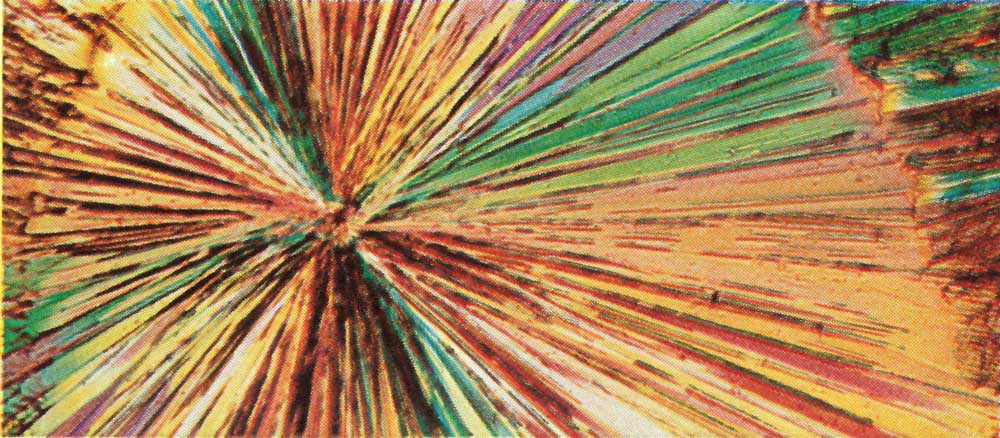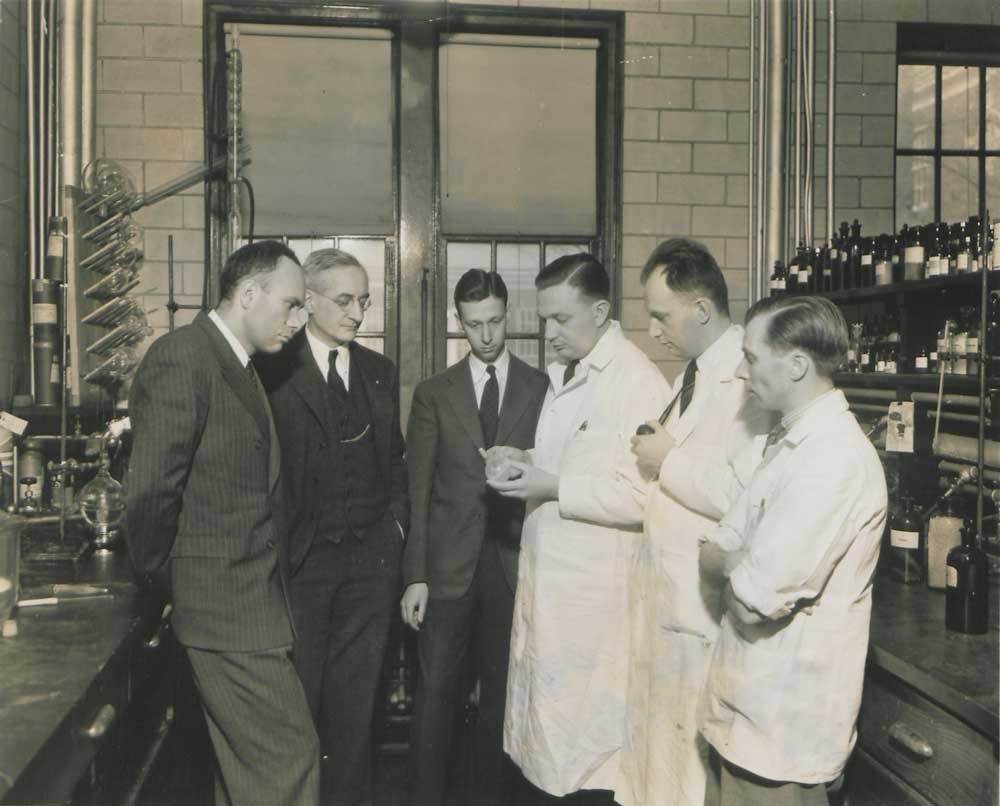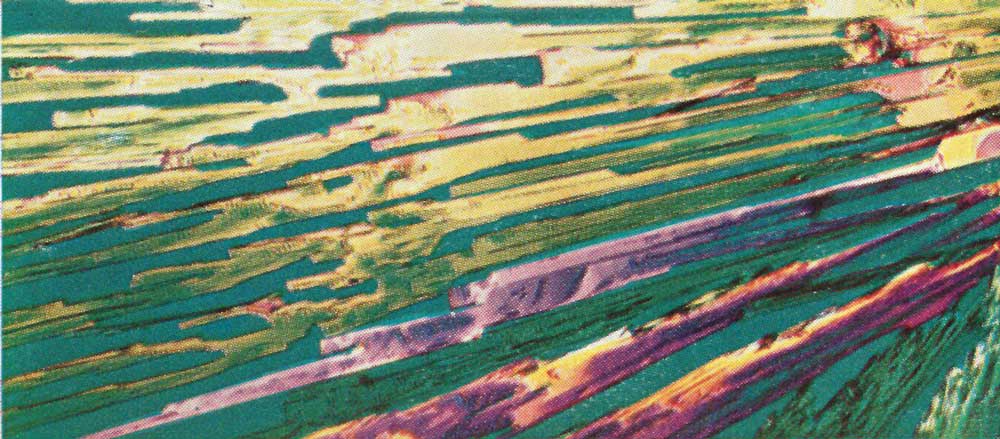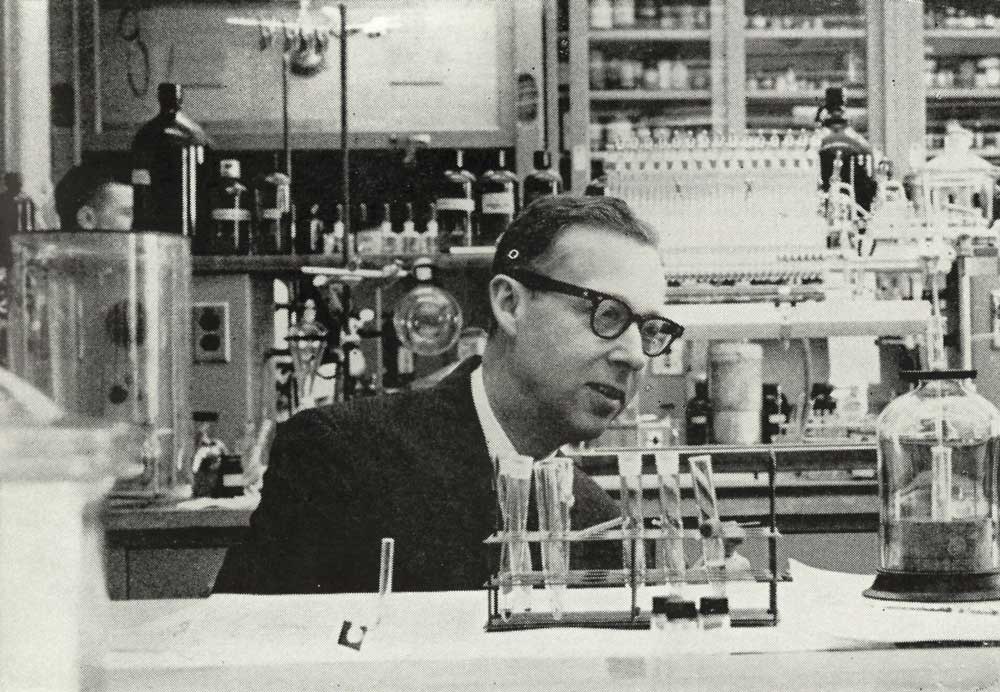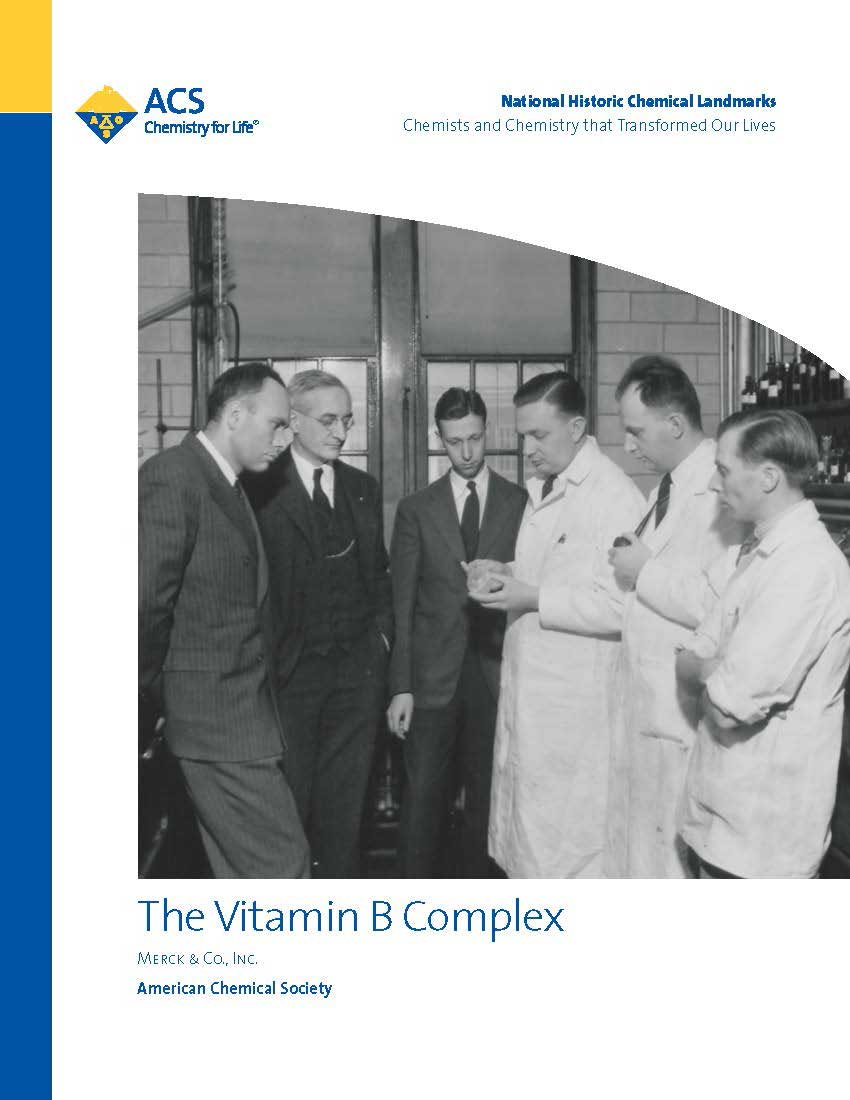The Vitamin B Complex
Dedicated at Merck & Co., Inc., on December 2, 2016.
The origins of our modern understanding of disease date to the 1860s, when Louis Pasteur (1822–1895) and others uncovered the role of microorganisms. Germ theory provided a revolutionary approach to medicine, and the impact of diseases such as cholera was dramatically reduced. And yet some diseases—such as scurvy, pellagra, anemia and beriberi—resisted all efforts by scientists to isolate the pathogens that were presumed to cause them.
Around 1900, physicians and scientists began to conceive of a new category of diseases, caused not by germs but by inadequate nutrition. Since that time, nutritional research has led to vast improvements in human and animal health. In particular, the research conducted by Merck scientists to isolate, determine chemical structures, and synthesize vitamins on an industrial scale—especially the B vitamins—is an outstanding example of the rapid advances in biochemistry and organic chemistry during the early 20th century.
Discovery of vitamins
In 1889, a Dutch physician named Christiaan Eijkman (1858–1930), working in the Dutch East Indies (now Indonesia), was investigating beriberi, an endemic condition that caused weakness, weight loss, confusion, and sometimes death. The disease was common in areas where refined rice comprised a large portion of the diet, such as in southern and southeastern Asia.
Eijkman studied the effects of dietary variations on the occurrence of beriberi, using chickens as animal models for his tests. He observed that chickens fed a diet of machine-polished white rice developed symptoms similar to beriberi, while those served unpolished brown rice did not. The research was advanced by his colleague Gerrit Grijns (1865–1944), who suggested that the bran of rice (present in brown rice but removed in white) contained a substance “which cannot be absent without serious injury.”
In 1906, English biochemist Frederick Gowland Hopkins (1861–1947) suggested a connection between nutrition and diseases like beriberi and scurvy. Hopkins had conducted feeding tests on animals, providing them diets of purified fats, proteins and carbohydrates, only to discover that the combination failed to sustain growth. Hopkins reasoned that there must be essential nutritional substances outside of these categories, which he called “accessory food factors.”
In 1911, Casimir Funk (1884–1967), a Polish biochemist working in London, further advanced this idea. He proposed that hitherto unknown organic substances, for which he coined the word “vitamines,” were required in tiny amounts in order to maintain health. This word combined the words “vital” and “amine,” a nitrogen-containing group in organic molecules. (Researchers later found that not all vitamins possess amine structures, but the term had already caught on, though without the final “e.”) In 1913, University of Wisconsin biochemist Elmer McCollum (1879–1967) was able to distinguish two different species of vitamins, which he called “fat-soluble factor A” and “water-soluble factor B.” The announcements by Hopkins, Funk, McCollum and others sparked enormous worldwide interest in this new area of research.
Once the connection between nutrition and vitamin-deficiency diseases had been established, the task of discovering the specific compounds that comprise vitamins began in earnest. In 1926, Dutch chemists Barend Jansen (1884–1962) and Willem Donath (1889–1957), also working in the Dutch East Indies, isolated crystals of the anti-beriberi factor from extracts of rice polishings. Eijkman tested the compound and found that it cured the disease in birds. The anti-beriberi factor was the first vitamin to be isolated, confirming the theories of Hopkins and Funk. It was later named vitamin B1 or thiamine (also spelled thiamin).
We made up our minds that we’re going to specialize in research in the field of vitamins. We’re going to isolate every vitamin. We’re going to determine their structures if it hasn’t already been done and synthesize them and make them available.”
—Randolph Major, as told by Max Tishler, 1983
The new vitamin: thiamine
Chemists throughout the world—particularly those at pharmaceutical companies—raced to isolate, characterize and synthesize vitamins. Merck had already begun this task by the 1930s, but reports of progress by others in the field accelerated the company’s efforts. When Robert Williams (1886–1965) of Bell Laboratories (who had previously investigated the anti-beriberi factor in the Philippines) approached Merck to help isolate and produce thiamine, the company’s research division enthusiastically embraced vitamin research.
Randolph Major (1901–1976) was chosen to head the new research and development laboratory Merck built as part of its efforts to grow basic research. These facilities, combined with a new Institute of Therapeutic Research designed to conduct clinical trials for the company, provided a solid grounding for vitamin research. Merck was quickly able to isolate thiamine and test it in humans. In 1936, Williams and a young organic chemist at Merck named Joseph Cline (1908–1989) synthesized the vitamin, beating out competing teams from Germany and England.
The achievement was cause for celebration because of thiamine’s demonstrated value at treating disease. Within a few years Merck was producing thiamine commercially by means of a challenging 15-step synthesis, a highly complex undertaking for a pharmaceutical company at the time. Synthesized thiamine was used to improve human nutrition, first in England and the U.S., and eventually globally. Vitamin-enriched foods, particularly bread flour, were popularized as a means to reinstate the vitamins that were lost in grain processing.
Merck research on the B vitamins
Following its success with thiamine, Merck ramped up its work on vitamins. Company leaders announced an initiative to research every vitamin—to isolate, determine the structures, synthesize and market them. Led by Major, Merck’s scientists undertook their work with the knowledge that vitamin-enriched foods and vitamin supplements would prevent the diseases of malnutrition.
New talent was brought in to advance these efforts, including chemists Karl Folkers (1906–1997) in 1934 and Max Tishler (1906–1989) in 1937. Folkers would later lead Merck’s research division, while Tishler would become his counterpart in developing the products of that research.
Vitamin B2 (riboflavin) had been discovered in 1922 by Richard Kuhn (1900–1967) in Germany and Theodor Wagner-Jauregg (1903–1992) in Austria. The compound was isolated in 1933 by Kuhn and Paul György (1893–1976) in Germany. Kuhn also developed a synthetic route to riboflavin which was licensed to the German company I. G. Farben; meanwhile, in Switzerland, Hoffmann-LaRoche held patents for another method of synthesis from Paul Karrer (1889–1971). Because the two companies refused to license their methods to Merck for riboflavin production in the U.S., Tishler’s first major task was to develop an alternative method for industrial synthesis. This was achieved within two years.
Vitamin B6 (pyridoxine) was discovered in 1934 by György and colleagues, and the active compound was first isolated by Samuel Lepovsky (1901–1984) of the University of California, Berkeley, in 1938. Folkers and his Merck colleague Stanton Harris (1902–1992) determined the structure of pyridoxine in 1939, simultaneously with Kuhn in Germany. The synthesis of vitamin B5 (pantothenic acid) followed, reported by Merck in 1940.
Discovery of vitamin B12 (cobalamin)
The final chapter of the B vitamins was among the most challenging. In the mid-1800s—well before vitamins were recognized—physicians in England had identified the disease pernicious anemia, a disorder that results in too few red blood cells being produced in the body. The disease causes subjects to feel tired and breathless, and it can be lethal.
In 1926, a team of physicians from Harvard University discovered that eating half a pound of liver every day would prevent pernicious anemia in most patients. From this point, researchers worldwide sought to isolate the anemia-preventing substance from liver.
Prior to the search for this vitamin, animal screening was used to test the effects of various diets and nutrients. But for pernicious anemia there appeared to be no suitable animal analog of the disease. The only alternative then available was to conduct tests on human patients. Folkers worked with Randolph West (1890–1949) of Columbia University to find patients willing to participate and feed them various liver extractions. The researchers worked slowly, forced to wait weeks in their search for patients with pernicious anemia due to the rarity of the disease.
A fortunate coincidence led to a critical advance: Folkers learned that Mary Shorb (1907–1990), a microbiologist formerly with the U.S. Department of Agriculture, had identified a bacterium that responded to liver extracts. Folkers recognized that the bacteria could be used as a stand-in for human subjects, and he brought Shorb to Merck to speed his research.
The researchers recognized that the liver extracts which produced the most promising effect in Shorb’s bacteria were pinkish in color—suggesting that the sought-after vitamin was a red compound. In 1947, Folkers and his team isolated vitamin B12 (cobalamin), producing tiny, bright red crystals of the vitamin. The following year, this new compound was tested on a patient who suffered from pernicious anemia, curing her.
Cobalamin was later found to be a key growth factor in animals. This realization led to the practice of enhancing animal diets with the vitamin, which led to greatly increased yields for livestock farmers.
Vitamins today
The story of how vitamins went from a medical curiosity to a daily routine for millions of Americans encompasses a worldwide quest to understand malnutrition and to develop protocols to prevent it. Before the discovery and widespread availability of vitamins, diseases caused by malnutrition took an incalculable human toll. Research and development of these essential nutrients represented a transition for pharmaceutical companies like Merck. As a result they acquired new skills in the fields of organic chemistry and biochemistry. Their work vastly improved the health of humans and animals by overcoming the scourge of malnutrition.
I think the Merck laboratories, with Karl Folkers behind it, probably has done more work on the isolation, structure, and synthesis of vitamins than any other laboratory in the country—in the world for that matter.”
—Max Tishler, 1983
Landmark dedication and acknowledgments
Landmark dedication
The American Chemical Society designated Merck's research on the vitamin B complex as a National Historic Chemical Landmark in Rahway, New Jersey, on December 2, 2016. The commemorative plaque reads:
In the 1930s and 1940s, Merck scientists reported a series of advances in the study of the vitamin B complex, a group of nutrients that is essential to cell functioning. This included the first industrial synthesis of B1 (thiamine), B2 (riboflavin) and B5 (pantothenic acid); the isolation, structure determination and industrial synthesis of B6 (pyridoxine, pyridoxamine and pyridoxal); and the isolation of B12 (cobalamin). Availability of these vitamins resulted in dietary supplements and vitamin-enriched foods that encouraged healthy growth and development, as well as treatments for diseases caused by nutritional deficiencies. These achievements were outstanding examples of the rapid advances occurring in the fields of biochemistry and organic chemistry during this era and led to notable improvements in human and animal health and nutrition.
Acknowledgments
Adapted for the internet from "The Vitamin B Complex," produced by the American Chemical Society's National Historic Chemical Landmarks program in 2016.
Research resources
Further reading
- The Vitamin B Complex (American Chemical Society NHCL booklet; PDF)
- Our History (Merck)
- Vitamins come to dinner (Distillations, Chemical Heritage Foundation)
- Max Tishler, 1906-1989 (National Academy of Sciences)
- Karl Folkers, 1906-1997 (National Academy of Sciences)
Cite this page
American Chemical Society National Historic Chemical Landmarks. The Vitamin B Complex. http://www.acs.org/content/acs/en/education/whatischemistry/landmarks/vitamin-b-complex.html (accessed Month Day, Year).


